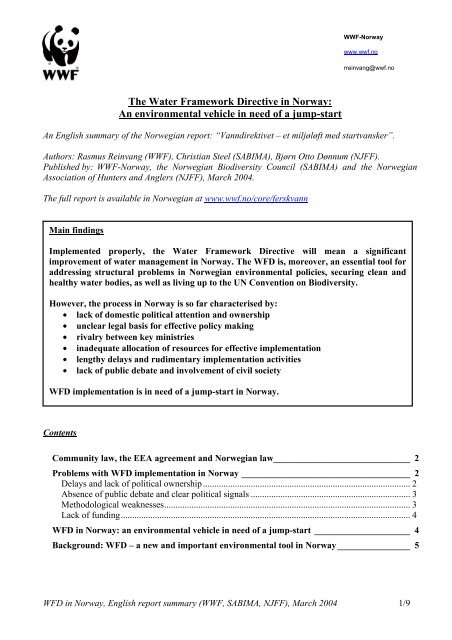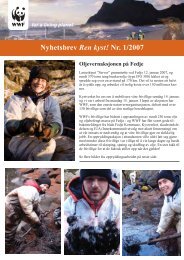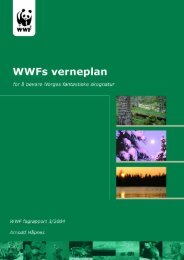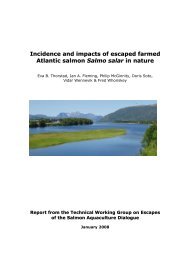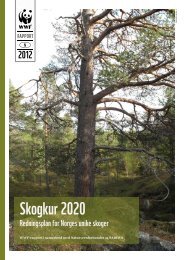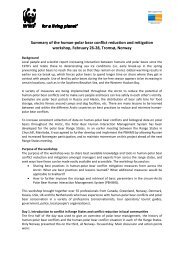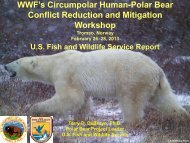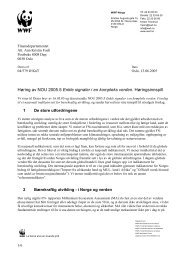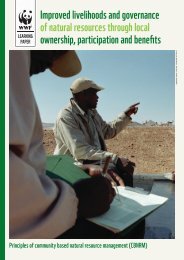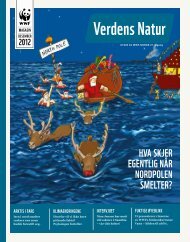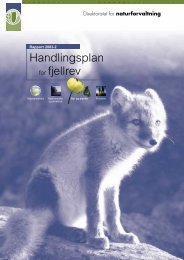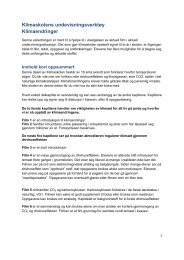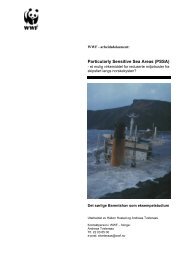The Water Framework Directive in Norway: An environmental ... - WWF
The Water Framework Directive in Norway: An environmental ... - WWF
The Water Framework Directive in Norway: An environmental ... - WWF
Create successful ePaper yourself
Turn your PDF publications into a flip-book with our unique Google optimized e-Paper software.
<strong>The</strong> <strong>Water</strong> <strong>Framework</strong> <strong>Directive</strong> <strong>in</strong> <strong>Norway</strong>:<br />
<strong>An</strong> <strong>environmental</strong> vehicle <strong>in</strong> need of a jump-start<br />
<strong>WWF</strong>-<strong>Norway</strong><br />
www.wwf.no<br />
rre<strong>in</strong>vang@wwf.no<br />
<strong>An</strong> English summary of the Norwegian report: “Vanndirektivet – et miljøløft med startvansker”.<br />
Authors: Rasmus Re<strong>in</strong>vang (<strong>WWF</strong>), Christian Steel (SABIMA), Bjørn Otto Dønnum (NJFF).<br />
Published by: <strong>WWF</strong>-<strong>Norway</strong>, the Norwegian Biodiversity Council (SABIMA) and the Norwegian<br />
Association of Hunters and <strong>An</strong>glers (NJFF), March 2004.<br />
<strong>The</strong> full report is available <strong>in</strong> Norwegian at www.wwf.no/core/ferskvann<br />
Ma<strong>in</strong> f<strong>in</strong>d<strong>in</strong>gs<br />
Implemented properly, the <strong>Water</strong> <strong>Framework</strong> <strong>Directive</strong> will mean a significant<br />
improvement of water management <strong>in</strong> <strong>Norway</strong>. <strong>The</strong> WFD is, moreover, an essential tool for<br />
address<strong>in</strong>g structural problems <strong>in</strong> Norwegian <strong>environmental</strong> policies, secur<strong>in</strong>g clean and<br />
healthy water bodies, as well as liv<strong>in</strong>g up to the UN Convention on Biodiversity.<br />
However, the process <strong>in</strong> <strong>Norway</strong> is so far characterised by:<br />
• lack of domestic political attention and ownership<br />
• unclear legal basis for effective policy mak<strong>in</strong>g<br />
• rivalry between key m<strong>in</strong>istries<br />
• <strong>in</strong>adequate allocation of resources for effective implementation<br />
• lengthy delays and rudimentary implementation activities<br />
• lack of public debate and <strong>in</strong>volvement of civil society<br />
WFD implementation is <strong>in</strong> need of a jump-start <strong>in</strong> <strong>Norway</strong>.<br />
Contents<br />
Community law, the EEA agreement and Norwegian law______________________________ 2<br />
Problems with WFD implementation <strong>in</strong> <strong>Norway</strong> _____________________________________ 2<br />
Delays and lack of political ownership........................................................................................... 2<br />
Absence of public debate and clear political signals ...................................................................... 3<br />
Methodological weaknesses............................................................................................................ 3<br />
Lack of fund<strong>in</strong>g............................................................................................................................... 4<br />
WFD <strong>in</strong> <strong>Norway</strong>: an <strong>environmental</strong> vehicle <strong>in</strong> need of a jump-start _____________________ 4<br />
Background: WFD – a new and important <strong>environmental</strong> tool <strong>in</strong> <strong>Norway</strong>________________ 5<br />
WFD <strong>in</strong> <strong>Norway</strong>, English report summary (<strong>WWF</strong>, SABIMA, NJFF), March 2004 1/9
Community law, the EEA agreement and Norwegian law<br />
<strong>The</strong> <strong>Water</strong> <strong>Framework</strong> <strong>Directive</strong> (2000/60/EC) – hereafter referred to as WFD - is considered one of<br />
the most important <strong>environmental</strong> directives of the EU. <strong>Norway</strong>’s day-to-day relationship with the EU<br />
is governed by the European Economic Area (EEA) agreement. <strong>The</strong> EEA agreement secures<br />
unh<strong>in</strong>dered Norwegian access to the EU <strong>in</strong>ternal market (except for the agriculture and fisheries<br />
sectors) <strong>in</strong> exchange for Norwegian adaptation to Community legislation perta<strong>in</strong><strong>in</strong>g to the <strong>in</strong>ternal<br />
market as well as flank<strong>in</strong>g policies (<strong>in</strong>clud<strong>in</strong>g environment issues).<br />
<strong>Norway</strong> has for several years participated <strong>in</strong> the development of the WFD and <strong>in</strong> the WFD work<strong>in</strong>g<br />
groups perta<strong>in</strong><strong>in</strong>g to the Common Implementation Strategy. <strong>Norway</strong> is officially committed to<br />
implement<strong>in</strong>g the WFD through the framework of the EEA-agreement. <strong>The</strong> transposition of WFD<br />
<strong>in</strong>to national law was accord<strong>in</strong>g to directive deadl<strong>in</strong>es to take place by December 2003. This has not<br />
yet happened <strong>in</strong> <strong>Norway</strong>, due to (<strong>in</strong>ter alia) a delay related to various operational issues relat<strong>in</strong>g to the<br />
EEA-mechanism. <strong>Norway</strong> cannot unilaterally <strong>in</strong>clude WFD <strong>in</strong>to the EEA-framework as the EEA-<br />
EFTA countries speak with one voice <strong>in</strong> all EEA-matters. <strong>Norway</strong> is currently await<strong>in</strong>g Iceland’s<br />
acceptance for <strong>in</strong>tegrat<strong>in</strong>g WFD <strong>in</strong>to the EEA-agreement. It is expected that the WFD will become<br />
part of the EEA agreement at the end of 2004. <strong>Norway</strong> will at that po<strong>in</strong>t be obliged to implement the<br />
directive accord<strong>in</strong>g to common standards and directive deadl<strong>in</strong>es. <strong>The</strong> EFTA Surveillance Authority<br />
is responsible for monitor<strong>in</strong>g that <strong>Norway</strong> is implement<strong>in</strong>g EEA-legislation properly and <strong>in</strong> time.<br />
Problems with WFD implementation <strong>in</strong> <strong>Norway</strong><br />
Delays and lack of political ownership<br />
<strong>Norway</strong> is beh<strong>in</strong>d schedule <strong>in</strong> implement<strong>in</strong>g the WFD. It is clear that the EEA-delay is merely due to<br />
procedural problems that will be overcome <strong>in</strong> due course and <strong>in</strong>evitably <strong>Norway</strong> will thus be legally<br />
obliged to implement the directive. <strong>The</strong> EEA-agreement does not make any concessions for delays <strong>in</strong><br />
implementation of Community legislation <strong>in</strong>tegrated <strong>in</strong>to the EEA, <strong>in</strong> spite of the at times timeconsum<strong>in</strong>g<br />
procedural issues. When the WFD eventually becomes part of the EEA-agreement and is<br />
officially transposed <strong>in</strong> Norwegian law, WFD deadl<strong>in</strong>es will be valid for <strong>Norway</strong> with retroactive<br />
effect. In light of this and <strong>Norway</strong>’s official commitment to implement the WFD, an implementation<br />
process has begun <strong>in</strong> <strong>Norway</strong> that is supposed to follow WFD deadl<strong>in</strong>es.<br />
<strong>The</strong> Norwegian government has not kept the WFD deadl<strong>in</strong>e for adjust<strong>in</strong>g the national law to the<br />
demands of the directive, for determ<strong>in</strong><strong>in</strong>g new water regions as adm<strong>in</strong>istrative units, or appo<strong>in</strong>t<strong>in</strong>g a<br />
superior responsible authority and the responsible authorities with<strong>in</strong> each region. <strong>The</strong> different<br />
authorities’ responsibilities <strong>in</strong> relation to WFD implementation should also have been def<strong>in</strong>ed and<br />
suitable rout<strong>in</strong>es of co-operation established. This should have been <strong>in</strong> place by 22 December 2003.<br />
<strong>The</strong>se delays are to a large extent due to disagreement with<strong>in</strong> the government as to whether the<br />
M<strong>in</strong>istry of Environment or the M<strong>in</strong>istry of Oil and Energy should have the overall responsibility for<br />
implement<strong>in</strong>g the WFD <strong>in</strong> <strong>Norway</strong>. Hydropower is important <strong>in</strong> <strong>Norway</strong> and the M<strong>in</strong>istry of Oil and<br />
Energy has up until now been responsible for water management <strong>in</strong> general terms. Environmental<br />
NGOs <strong>in</strong> <strong>Norway</strong> have argued that the M<strong>in</strong>istry of Environment is best suited to be given the formal<br />
mandate to oversee implementation of the WFD, as the WFD is <strong>environmental</strong> legislation (the legal<br />
base be<strong>in</strong>g §175, [1] <strong>in</strong> the Treaty) regulat<strong>in</strong>g water management <strong>in</strong> light of an overall ecological<br />
approach. It is at present not clear when a decision will be made concern<strong>in</strong>g which Norwegian<br />
m<strong>in</strong>istry will be responsible for WFD implementation.<br />
WFD <strong>in</strong> <strong>Norway</strong>, English report summary (<strong>WWF</strong>, SABIMA, NJFF), March 2004 2/9
Absence of public debate and clear political signals<br />
<strong>The</strong> maybe most significant problem emerg<strong>in</strong>g with regard to the cont<strong>in</strong>u<strong>in</strong>g delay is that it has<br />
prevented a broad public debate concern<strong>in</strong>g the national level of ambition <strong>in</strong> implement<strong>in</strong>g the WFD<br />
and how to best <strong>in</strong>terpret the cont<strong>in</strong>gent objectives <strong>in</strong> the Norwegian context. <strong>An</strong> extensive, national<br />
debate about goals and tools should be considered as the foundation of any Norwegian WFD<br />
implementation. <strong>The</strong> lack of official leadership and def<strong>in</strong>ed responsibility for the WFD at present<br />
delays the implementation process <strong>in</strong> <strong>Norway</strong>, cont<strong>in</strong>ues to confuse <strong>in</strong>ter-departmental priorities and<br />
leaves goals and sectoral responsibilities ill def<strong>in</strong>ed. <strong>The</strong> net result of these factors is that WFD<br />
implementation at present consists of task-oriented work<strong>in</strong>g groups from different directorates<br />
carry<strong>in</strong>g out practical WFD implementation work, without clear political signals concern<strong>in</strong>g level of<br />
ambition and without participation from the public.<br />
Norwegian authorities have so far done a poor job of <strong>in</strong>clud<strong>in</strong>g civil society <strong>in</strong> the task of<br />
implement<strong>in</strong>g the WFD. Organisational structures and rout<strong>in</strong>es that can ensure active public<br />
participation have not been established. Moreover, no funds have been allocated to secure a broad cooperation<br />
over time between different <strong>in</strong>terested parties <strong>in</strong> carry<strong>in</strong>g out WFD tasks. Such funds are<br />
prerequisite for an effective and open implementation process <strong>in</strong> which different stakeholders are<br />
engaged actively to achieve common goals. So far, the implementation <strong>in</strong> <strong>Norway</strong> has primarily been<br />
a technocratic process <strong>in</strong> which basic implementation activities are carried out without openly<br />
address<strong>in</strong>g the overarch<strong>in</strong>g question on how the WFD can best be used as a tool for realis<strong>in</strong>g official<br />
Norwegian policy goals for environment.<br />
Two pilot projects have been carried out to test CIS-guidel<strong>in</strong>es for WFD-implementation <strong>in</strong> <strong>Norway</strong>,<br />
<strong>in</strong> Suldalslågen with external coastal areas <strong>in</strong> Rogaland County and the Vannsjø-Hobbøl watercourse<br />
(also called the Morsa watercourse) <strong>in</strong> Akershus and Østfold counties. No attempt has been made by<br />
the m<strong>in</strong>istries <strong>in</strong>volved to <strong>in</strong>clude Norwegian <strong>environmental</strong> NGOs on a national or regional level <strong>in</strong><br />
the actual work. <strong>The</strong> reports from the projects are available for the general public on the <strong>in</strong>ternet, but<br />
are highly technical and not easily accessible for <strong>in</strong>terested non-specialists. Only brief drafts of<br />
Norwegian versions of some of the Common Implementation Strategy guidel<strong>in</strong>es have been made,<br />
tucked <strong>in</strong> as appendices to the pilot river bas<strong>in</strong> test<strong>in</strong>g reports.<br />
Methodological weaknesses<br />
We are currently <strong>in</strong> the characterisation phase of WFD implementation. Norwegian authorities have<br />
so far carried out pilot characterisation <strong>in</strong> eight catchment areas, constitut<strong>in</strong>g a total of approximately<br />
10% of Norwegian water bodies. Accord<strong>in</strong>g to the pollution control authority (Statens<br />
Forurens<strong>in</strong>gstilsyn), only one out of eight catchments lives up to WFD demands <strong>in</strong> a strict sense. <strong>The</strong><br />
pilot characterisation exercise thus shows that even <strong>in</strong> comparatively clean <strong>Norway</strong>, it will be a major<br />
challenge, albeit a worthwhile one, to achieve the ambitious <strong>environmental</strong> goals of the WFD. (Cf.<br />
also current threats and problems for Norwegian water bodies, described <strong>in</strong> the Background section<br />
below).<br />
Substantial uncerta<strong>in</strong>ty is l<strong>in</strong>ked to the results of the pilot characterisation. Due to limited resources<br />
the pilot characterisation was carried out us<strong>in</strong>g pre-exist<strong>in</strong>g data produced under a water management<br />
regime with a much weaker focus on ecological factors than the WFD. Exist<strong>in</strong>g data primarily focuses<br />
on pollution, i.e. the chemical status of Norwegian water bodies. <strong>The</strong>re is little data on the status of<br />
the ecosystem (<strong>in</strong>clud<strong>in</strong>g terrestrial species) l<strong>in</strong>ked to the particular water body. It is therefore highly<br />
likely that a number of relevant ecological factors for ascerta<strong>in</strong><strong>in</strong>g the degree of compliance with<br />
WFD <strong>environmental</strong> goals are not fully disclosed <strong>in</strong> these reports.<br />
WFD <strong>in</strong> <strong>Norway</strong>, English report summary (<strong>WWF</strong>, SABIMA, NJFF), March 2004 3/9
Without a balanced perspective, there is every chance that the status of Norwegian water bodies is<br />
even worse than that portrayed by the pilot studies. Secondly, if failure to live up to the ecological<br />
standards <strong>in</strong> the directive is not disclosed fully <strong>in</strong> the characterisation reports, this will, for the water<br />
bodies <strong>in</strong> question, not be addressed <strong>in</strong> the follow-up management plans and <strong>in</strong>itiatives designed to<br />
achieve WFD goals. It would appear that a sloppy start is threaten<strong>in</strong>g to compromise the ecological<br />
dimension of the whole implementation process <strong>in</strong> <strong>Norway</strong>, at least <strong>in</strong> the first 12-year cycle.<br />
We should <strong>in</strong> this context also note that a number of problematic issues related to the characterisation<br />
process call for active <strong>in</strong>volvement of additional stakeholders. Issues concern<strong>in</strong>g the choice of scale,<br />
how to aggregate data relat<strong>in</strong>g to water bodies, identify<strong>in</strong>g what necessary data is miss<strong>in</strong>g and how to<br />
get it, should be subject to a comprehensive local debate with relevant stakeholders <strong>in</strong> light of<br />
particular regional conditions. Relevant authorities have not addressed such issues <strong>in</strong> an open and<br />
<strong>in</strong>clusive manner so far.<br />
Lack of fund<strong>in</strong>g<br />
<strong>The</strong> official, Norwegian WFD impact analysis (direktoratgruppens konsekvensutredn<strong>in</strong>g) from 2001<br />
po<strong>in</strong>ted out that a restructur<strong>in</strong>g of Norwegian water management <strong>in</strong> accordance with the guidel<strong>in</strong>es <strong>in</strong><br />
the WFD would imply <strong>in</strong>creased cost <strong>in</strong> the short term, but a substantial profit for society as a whole<br />
<strong>in</strong> the long term. <strong>The</strong> cross-m<strong>in</strong>isterial Norwegian WFD work<strong>in</strong>g group (direktoratsgruppen)<br />
authored this analysis and is at present responsible for practical implementation work <strong>in</strong> <strong>Norway</strong>. <strong>The</strong><br />
analysis estimated that the <strong>in</strong>creased adm<strong>in</strong>istrative cost connected with characterisation and <strong>in</strong>creased<br />
monitor<strong>in</strong>g would come to on average 15 mill. NOK annually for the period 2002 - 2005. In 2003 the<br />
work<strong>in</strong>g group received only 6 mill. NOK for implementation work. Also for 2004 the work<strong>in</strong>g group<br />
has received a much smaller amount for implementation work than what was called for. As a<br />
consequence the work<strong>in</strong>g group has chosen to extend the characterisation work until autumn 2005<br />
(i.e. a full year’s delay) <strong>in</strong> order to be able “to secure the necessary quality”. Thus far, <strong>in</strong>adequate<br />
government fund<strong>in</strong>g has seriously hampered WFD implementation <strong>in</strong> <strong>Norway</strong>. At this po<strong>in</strong>t even<br />
basic commitments and activities are not supported to an extent allow<strong>in</strong>g for compliance with the<br />
common WFD implementation schedule.<br />
WFD <strong>in</strong> <strong>Norway</strong>: an <strong>environmental</strong> vehicle <strong>in</strong> need of a jump-start<br />
<strong>The</strong> WFD <strong>in</strong>troduces a broad perspective to water management based on develop<strong>in</strong>g a partnership<br />
between relevant stakeholders and secur<strong>in</strong>g <strong>in</strong>tegrated water management with<strong>in</strong> the framework of<br />
strong <strong>environmental</strong> considerations. As such, the WFD is a valuable tool to address structural<br />
problems <strong>in</strong> Norwegian <strong>environmental</strong> policies and to achieve the goal of halt<strong>in</strong>g the loss of<br />
biodiversity before 2010 (see background below).<br />
However, the Norwegian government has so far shown little political <strong>in</strong>itiative to use this tool<br />
actively, nor has it harnessed the broad and ambitious process the WFD represents. This is <strong>in</strong> marked<br />
contrast to the ambitious and environment friendly role <strong>Norway</strong> has played <strong>in</strong> earlier stages of<br />
develop<strong>in</strong>g the WFD as a legal framework.<br />
Such is the extraord<strong>in</strong>ary variety and richness of <strong>Norway</strong>’s aquatic systems that the Norwegian<br />
M<strong>in</strong>ister of Environment, Mr. Børge Brende, last year was moved to describe the task of preserv<strong>in</strong>g<br />
these as <strong>Norway</strong>’s “ra<strong>in</strong>forest responsibility”. It is now time for the Norwegian government to live up<br />
to <strong>Norway</strong>’s “ra<strong>in</strong> forest responsibility”, by means of an active, ambitious and broad national WFD<br />
implementation strategy.<br />
WFD <strong>in</strong> <strong>Norway</strong>, English report summary (<strong>WWF</strong>, SABIMA, NJFF), March 2004 4/9
Background: WFD – a new and important <strong>environmental</strong> tool <strong>in</strong> <strong>Norway</strong><br />
<strong>The</strong> WFD provides a long-term framework for the management of freshwater resources (surface<br />
waters, coastal waters and groundwater) throughout Europe, <strong>in</strong>clud<strong>in</strong>g <strong>Norway</strong>. Indeed the WFD has<br />
very ambitious <strong>environmental</strong> goals for the region <strong>in</strong> that by 2015 all freshwater resources shall be of<br />
an ecologically susta<strong>in</strong>able level of quality and quantity - effectively restored to so-called “good<br />
chemical status” and “good ecological status”. “Good ecological status” means that only a slight<br />
departure from the biological community that would be expected <strong>in</strong> conditions of m<strong>in</strong>imal<br />
anthropogenic impact will be allowed. Essentially the WFD dictates that pollution, encroachments<br />
and other activities affect<strong>in</strong>g freshwater ecosystems will only be acceptable under certa<strong>in</strong> conditions.<br />
<strong>The</strong> strong focus on the ecological aspect of freshwater is someth<strong>in</strong>g new for Norwegian water<br />
management authorities and presents fresh challenges.<br />
<strong>The</strong> WFD <strong>in</strong>troduces a holistic perspective to water management, where the management of water is<br />
organised accord<strong>in</strong>g to catchment areas. This is new <strong>in</strong> <strong>Norway</strong> where water management<br />
responsibilities currently are divided between a wide range of m<strong>in</strong>istries, directorates and<br />
adm<strong>in</strong>istrative levels (counties, municipalities). <strong>The</strong> more comprehensive structure and holistic way of<br />
th<strong>in</strong>k<strong>in</strong>g <strong>in</strong> water management <strong>in</strong>troduced by the WFD will be a great advantage with regard to<br />
<strong>in</strong>creased efficiency and a more comprehensive management of Norwegian catchment areas. It will<br />
also be of great advantage to ecosystems that are under pressure due to a lack of overall<br />
<strong>environmental</strong> goals and mechanisms <strong>in</strong> the currently fragmented water management system.<br />
In brief, the WFD is good news for all Norwegian freshwater ecosystems and will be one of the most<br />
important tools for the Norwegian government to use <strong>in</strong> meet<strong>in</strong>g its UN Convention of Biodiversity<br />
obligations, as well as achiev<strong>in</strong>g the official goal of halt<strong>in</strong>g the loss of biodiversity <strong>in</strong> <strong>Norway</strong> with<strong>in</strong><br />
2010.<br />
Norwegian water ecosystems: unique, but threatened…<br />
<strong>Norway</strong> has an abundance of freshwater habitats and these vary considerably <strong>in</strong> their nature<br />
throughout the country. International geographical surveys place <strong>Norway</strong> near the top <strong>in</strong> all categories<br />
relat<strong>in</strong>g to the frequency and diversity of freshwater resources. <strong>The</strong> diverse topography and<br />
extraord<strong>in</strong>ary geology of <strong>Norway</strong> have comb<strong>in</strong>ed to produce many waterfalls, lakes, rivers, valleys<br />
and fjords that are among the most magnificent and renowned <strong>in</strong> the world. <strong>Norway</strong> has many unique<br />
freshwater environments and a correspond<strong>in</strong>g responsibility for manag<strong>in</strong>g these responsibly.<br />
<strong>Water</strong> is an essential <strong>in</strong>gredient for all life. In freshwater we encounter, amongst other th<strong>in</strong>gs, a<br />
multitude of mushrooms, algae, moss, vascular plants, <strong>in</strong>sects, spiders, crawfish, molluscs, fish,<br />
mammals and birds! <strong>The</strong> biological diversity is probably greater <strong>in</strong> and along watercourses than<br />
anywhere else <strong>in</strong> nature. In fact such is the extraord<strong>in</strong>ary variety and richness of <strong>Norway</strong>’s aquatic<br />
systems that the Norwegian M<strong>in</strong>ister of Environment, Mr. Børge Brende, was last year moved to<br />
describe the task of preserv<strong>in</strong>g these as <strong>Norway</strong>’s “ra<strong>in</strong>forest responsibility”.<br />
However, <strong>Norway</strong>’s water systems are today seriously threatened. <strong>Norway</strong>’s ecologically rich<br />
wetlands are recognised as a highly endangered biotope. Infrastructure development cont<strong>in</strong>ues to take<br />
place too close to the normal flow of watercourses, <strong>in</strong>fr<strong>in</strong>g<strong>in</strong>g upon the natural dynamics of river<br />
systems and negatively impact<strong>in</strong>g on wildlife. Furthermore this can also have negative flow-on effects<br />
for society, one economic consequence of such <strong>in</strong>frastructure development be<strong>in</strong>g repeated and costly<br />
flood damage. <strong>The</strong> natural biodiversity of Norwegian coastal waters and watercourses is also<br />
threatened. Mar<strong>in</strong>e habitats are besieged by alien species <strong>in</strong>troduced, <strong>in</strong>ter alia, courtesy of<br />
WFD <strong>in</strong> <strong>Norway</strong>, English report summary (<strong>WWF</strong>, SABIMA, NJFF), March 2004 5/9
<strong>in</strong>discrim<strong>in</strong>ate dump<strong>in</strong>g of ballast water by ships. One third of the total wild salmon stock <strong>in</strong> <strong>Norway</strong><br />
is ext<strong>in</strong>ct, seriously threatened or vulnerable. Due to mercury pollution <strong>in</strong> Norwegian watercourses the<br />
Norwegian Food Safety Authority advises pregnant and breastfeed<strong>in</strong>g women not to eat pike and<br />
perch above 25 cm, nor trout and char above 1 kg. <strong>The</strong> condition of 700 to 900 lakes is considered by<br />
national pollution control authorities to be bad or very bad due to discharges of phosphorous and/or<br />
nitrogen. In summary, physical encroachments, the <strong>in</strong>troduction of alien species and parasites, and<br />
pollution today constitute serious threats to the health of Norwegian water bodies.<br />
How does the WFD work <strong>in</strong> <strong>Norway</strong>?<br />
<strong>The</strong> WFD is a framework directive: It establishes the basic framework for the future of broader<br />
European water management <strong>in</strong> terms of <strong>environmental</strong> goals, lead<strong>in</strong>g pr<strong>in</strong>ciples and a time schedule<br />
for related activities. With<strong>in</strong> this framework, however, <strong>Norway</strong> is relatively free to choose the degree<br />
of commitment and <strong>in</strong>struments to use <strong>in</strong> implement<strong>in</strong>g the directive.<br />
<strong>The</strong> WFD is a large and complicated edict that will be implemented gradually over a number of years.<br />
<strong>The</strong> timeframe can briefly be summarised as follows:<br />
Topic Description Deadl<strong>in</strong>e<br />
1. Legal status and<br />
organisation<br />
<strong>The</strong> requirements of the WFD shall be transposed to national legislation. <strong>The</strong><br />
political responsibility for the implementation of the directive shall be allocated.<br />
<strong>The</strong> number of catchment areas shall be def<strong>in</strong>ed together with correspond<strong>in</strong>g<br />
adm<strong>in</strong>istrative units.<br />
2. Characterisation Mapp<strong>in</strong>g of Norwegian water bodies with regards to chemical, ecological and<br />
hydromorphological status, <strong>in</strong> order to identify water bodies where measures need<br />
to be taken <strong>in</strong> order to achieve WFD goals. <strong>An</strong> analysis of ma<strong>in</strong> pressures and<br />
impacts for each water catchment shall be made, together with an economic analysis<br />
of water use and water services.<br />
3. Intercalibration <strong>The</strong> Commision and EEA Member States determ<strong>in</strong>es a methodology to def<strong>in</strong>e a<br />
common understand<strong>in</strong>g of the qualitative terms “high”, “good”, “moderate”, “bad”<br />
and “very bad” which is comparable across Europe.<br />
4. Monitor<strong>in</strong>g A programme secur<strong>in</strong>g the necessary monitor<strong>in</strong>g of the qualitative <strong>in</strong>dicators <strong>in</strong> the<br />
5. Development of<br />
action and<br />
management plans<br />
6.Implementation of<br />
catchments shall be developed<br />
<strong>An</strong> action plan describ<strong>in</strong>g the necessary measures to be taken to achieve the<br />
<strong>environmental</strong> goals <strong>in</strong> the catchment area shall be developed and <strong>in</strong>tegrated with<br />
the management plan for the catchment area.<br />
December<br />
2003<br />
December<br />
2004<br />
June 2006<br />
December<br />
2006<br />
December<br />
2009<br />
<strong>The</strong> action plan is implemented December<br />
measures<br />
2012<br />
7. Realisation period Allowed time for the employed measures to have effect and realisation of WFD December<br />
<strong>environmental</strong> goals<br />
2015<br />
<strong>The</strong> WFD will thus be implemented over a period of 12 years. New technology and a better<br />
understand<strong>in</strong>g of relevant circumstances will develop dur<strong>in</strong>g this period, <strong>in</strong> light of which it will be<br />
possible to consecutively improve on efforts to achieve the ambitious <strong>environmental</strong> goals of the<br />
directive. Us<strong>in</strong>g this framework, the directive will operate with a view to cont<strong>in</strong>uous improvement.<br />
When the first cycle is completed <strong>in</strong> 2012, a new cycle will beg<strong>in</strong> at which time the WFD will be<br />
revised and updated.<br />
Exceptions and alternative <strong>environmental</strong> goals<br />
When the WFD was be<strong>in</strong>g developed, the EU member states and <strong>Norway</strong> adopted the basic and<br />
pr<strong>in</strong>cipally important stance that the goal of the WFD is to ensure that all water bodies atta<strong>in</strong> or<br />
uphold its natural condition (“good ecological status” and “good chemical status”). It is clear,<br />
WFD <strong>in</strong> <strong>Norway</strong>, English report summary (<strong>WWF</strong>, SABIMA, NJFF), March 2004 6/9
however, that for some water bodies this will not be possible, as they have been modified to serve<br />
essential functions for society – such as water bodies utilised to produce hydropower. WFD thus<br />
allows for certa<strong>in</strong> water bodies to be excepted from the overall <strong>environmental</strong> goals of the directive<br />
under strict conditions.<br />
A water body can for <strong>in</strong>stance be def<strong>in</strong>ed as an “artificial” or “heavily modified water body”<br />
(HMWB) under certa<strong>in</strong> conditions: It must have been subject to a physical encroachment affect<strong>in</strong>g the<br />
ecology of the water body and the <strong>in</strong>itiatives necessary <strong>in</strong> order to reverse these effects must be<br />
disproportionally costly or violat<strong>in</strong>g overrid<strong>in</strong>g <strong>in</strong>terests of society. For such water bodies (typically<br />
reservoirs, harbours, piped rivers <strong>in</strong> cities, channels l<strong>in</strong>ked to <strong>in</strong>frastructure etc.) the WFD operates<br />
with an alternative and mandatory ecological goal called “good ecological potential”. Norwegian<br />
authorities will thus for HMWB’s be obliged to achieve “good ecological potential” and “good<br />
chemical status” for each specific <strong>in</strong>stance of this classification. Achiev<strong>in</strong>g good ecological potential<br />
requires that the composition and concentration of animal and plant species <strong>in</strong> the water body is as<br />
close to “good ecological status” as possible given the presence of the specific physical encroachment.<br />
Openness and <strong>in</strong>tegration of <strong>in</strong>terested parties<br />
<strong>The</strong> WFD <strong>in</strong>troduces a new way of th<strong>in</strong>k<strong>in</strong>g about Norwegian water management and establishes a<br />
framework for a comprehensive management system <strong>in</strong> which all user <strong>in</strong>terests are to be balanced <strong>in</strong><br />
accordance with ambitious <strong>environmental</strong> goals. <strong>The</strong> WFD emphasises that this requires a broad and<br />
open implementation process, where all <strong>in</strong>terested parties are <strong>in</strong>cluded <strong>in</strong> the national development<br />
and implementation related to liv<strong>in</strong>g up to WFD requirements. In WFD article 14 it is emphasised that<br />
authorities are strongly encouraged to ensure “active <strong>in</strong>volvement” of all <strong>in</strong>terested parties <strong>in</strong> the<br />
implementation of the directive. It is further emphasised that the public shall have access to all<br />
background <strong>in</strong>formation related to implementation. <strong>The</strong> directive also stresses that the assignment of<br />
HMWB status to a water body shall be an open process based on clear and transparent criteria.<br />
<strong>The</strong> importance of WFD for different sectors <strong>in</strong> <strong>Norway</strong><br />
Hydropower: Stronger <strong>environmental</strong> demands and focus on sav<strong>in</strong>g energy<br />
<strong>The</strong> WFD puts restrictions on all water users <strong>in</strong>fluenc<strong>in</strong>g the ecological and chemical condition of a<br />
water body. <strong>Water</strong> use that substantially <strong>in</strong>fluences the morphology of a water body can only be<br />
legitimised by document<strong>in</strong>g that it serves an overrid<strong>in</strong>g <strong>in</strong>terest of society as a whole. Likewise, it<br />
must also be proven that no alternative solution could fulfil the same needs of society with less impact.<br />
<strong>The</strong> WFD thus implies that hydropower development <strong>in</strong> each case must be evaluated aga<strong>in</strong>st other<br />
solutions, such as for <strong>in</strong>stance develop<strong>in</strong>g alternative energy systems and power sav<strong>in</strong>g campaigns.<br />
<strong>The</strong> WFD will make it more difficult than it is today for Norwegian authorities to further develop<br />
water bodies for hydropower production, as there is a large and documented potential for exploit<strong>in</strong>g<br />
other renewable energy sources and cutt<strong>in</strong>g energy consumption through energy efficiency <strong>in</strong>itiatives.<br />
This is highly relevant <strong>in</strong> light of current plans for hydropower development of for <strong>in</strong>stance the<br />
Vefsna river system <strong>in</strong> Trøndelag County, one of the few rema<strong>in</strong><strong>in</strong>g large, untouched river systems <strong>in</strong><br />
<strong>Norway</strong>.<br />
Less development <strong>in</strong> the river zone: more restrictions on the municipality<br />
Norwegian municipalities have a long tradition of permitt<strong>in</strong>g development close to rivers (i.e. with<strong>in</strong><br />
the 10-year-floodmark). This causes <strong>in</strong>creased pollution of the watercourse, loss of biodiversity and<br />
<strong>in</strong>creased problems with flood<strong>in</strong>g. Currently there are no restrictions <strong>in</strong> Norwegian law govern<strong>in</strong>g<br />
WFD <strong>in</strong> <strong>Norway</strong>, English report summary (<strong>WWF</strong>, SABIMA, NJFF), March 2004 7/9
plann<strong>in</strong>g and build<strong>in</strong>g (Plan- og byggn<strong>in</strong>gsloven) that directly support the <strong>environmental</strong> demands of<br />
Norwegian water legislation (Vannressursloven). <strong>The</strong> implementation of the WFD should ensure that<br />
a more <strong>in</strong>tegrated and co-operative legal framework is developed <strong>in</strong> <strong>Norway</strong> with regards to water<br />
management. This will impose more restrictions than exist today on municipalities wish<strong>in</strong>g to develop<br />
areas connected with water (wetlands, deltas, coastal areas, clos<strong>in</strong>g of brooks etc.). When WFD<br />
requirements are operationalised, development <strong>in</strong> the flood-zone of a river will only be permitted <strong>in</strong><br />
exceptional cases. Norwegian municipalities will, moreover, be obliged to restore water bodies to<br />
“good ecological status” to the extent that this is possible.<br />
Genetic pollution: new and stronger demands for aquaculture<br />
<strong>The</strong> salmon louse gyrodactylus salaris and other such fish diseases carried by runaway farmed fish<br />
are problems that affect the wild salmon population <strong>in</strong> <strong>Norway</strong>. With this, runaway farmed fish<br />
<strong>in</strong>fluence negatively upon the ecological condition of water bodies with wild salmon populations.<br />
Liv<strong>in</strong>g up to WFD requirements for such water bodies will back up and if necessary, strengthen the<br />
<strong>in</strong>itiatives to tackle these problems, based on the polluter pays pr<strong>in</strong>ciple. In Namsen river <strong>in</strong> Trøndelag<br />
County up to 50 % of the salmon population consists of farmed salmon that has escaped from fish<br />
farms, consist<strong>in</strong>g a direct threat to the <strong>in</strong>tegrity of the wild salmon stock <strong>in</strong> this river system. In light<br />
of WFD <strong>environmental</strong> demands it is clear that the presence of escaped farmed salmon <strong>in</strong> this and<br />
other Norwegian rivers, must be reduced to a level approach<strong>in</strong>g zero tolerance <strong>in</strong> order to live up to<br />
the “good ecological status”. In light of the WFD economic analysis of each catchment area and the<br />
application of the “polluter pays” pr<strong>in</strong>ciple, the aquaculture <strong>in</strong>dustry will be obliged to participate <strong>in</strong><br />
cover<strong>in</strong>g costs related to achiev<strong>in</strong>g the necessary ecological standard for these rivers.<br />
Pollution: new and stronger demands on agriculture and other sectors<br />
Norwegian pollution control authorities have <strong>in</strong> a pilot project evaluated eight Norwegian<br />
watercourses aga<strong>in</strong>st the <strong>environmental</strong> demands of the WFD. <strong>The</strong> conclusion was that for seven of<br />
eight watercourses there is still a long way to go. Orrevassdraget <strong>in</strong> Rogaland County and<br />
Haldenvassdraget <strong>in</strong> Akershus County came out worst. In these cases pollution of salts and nutrients<br />
from agriculture were the ma<strong>in</strong> reason for the poor condition of water quality. <strong>The</strong> WFD will mean<br />
<strong>in</strong>creased surveillance of the pollution affect<strong>in</strong>g Norwegian watercourses and we can expect stricter<br />
demands with regards to agricultural pollution as well as on <strong>in</strong>dustrial and municipal waste water<br />
treatment plants.<br />
Pollution from sediments is another considerable <strong>environmental</strong> problem <strong>in</strong> <strong>Norway</strong>, especially <strong>in</strong><br />
Norwegian fjords. Advice on food <strong>in</strong>take has been issued to the general public due to the high content<br />
of tox<strong>in</strong>s (PCB, PAH, TBT, diox<strong>in</strong>s) found <strong>in</strong> fish and/or shellfish <strong>in</strong> approximately 30 Norwegian<br />
fjords. <strong>The</strong> WFD’s water quality requirements will demand that stronger <strong>in</strong>itiatives be implemented to<br />
reverse the effects of pollution caused by <strong>in</strong>dustrial effluents, shipyards and harbours, municipal<br />
dra<strong>in</strong>age as well as rubbish dumps and polluted soil affect<strong>in</strong>g water catchments.<br />
Infrastructure development: restriction and <strong>in</strong>creased focus on mitigat<strong>in</strong>g measures<br />
Both exist<strong>in</strong>g and future <strong>in</strong>frastructure (roads, railway, airports, settlements etc.) may come <strong>in</strong>to<br />
strong conflict with the <strong>environmental</strong> goals of the WFD. In reality, the WFD does allow for further<br />
<strong>in</strong>frastructure development that may actually oppose its goals, but only if the benefits for society of<br />
such encroachments are very large and if there are no better ways of address<strong>in</strong>g the specific societal<br />
need <strong>in</strong> question. This will, however, have to be tried <strong>in</strong> an open process <strong>in</strong> each case and accord<strong>in</strong>g to<br />
strict criteria. If an exemption from the directive’s goals is allowed, the developer <strong>in</strong> question is<br />
WFD <strong>in</strong> <strong>Norway</strong>, English report summary (<strong>WWF</strong>, SABIMA, NJFF), March 2004 8/9
committed to <strong>in</strong>troduce mitigat<strong>in</strong>g measures to secure the best ecological condition possible given the<br />
specific, physical <strong>in</strong>fluence on the water body. Further still, the specific development will only be<br />
allowed if it does not jeopardize the objectives of other EEA-legislation nor the status of another<br />
water body <strong>in</strong> the same river bas<strong>in</strong>. All <strong>in</strong> all it seems clear that the WFD will require a stronger legal<br />
and political commitment to ecologically susta<strong>in</strong>able management of water bodies, <strong>in</strong> order to achieve<br />
compliance with the terms of the directive. This <strong>in</strong>cludes protect<strong>in</strong>g (and <strong>in</strong> some cases restor<strong>in</strong>g) the<br />
fragile ecological balance of aquatic systems as well adopt<strong>in</strong>g a more cautious and regulated approach<br />
to <strong>in</strong>frastructure development that affects such water bodies.<br />
WFD <strong>in</strong> <strong>Norway</strong>, English report summary (<strong>WWF</strong>, SABIMA, NJFF), March 2004 9/9


